Text
We're celebrating Autonomous Vehicle Day with a sticker giveaway! 🤖
Autonomous robots are essential to the future of marine science, engineering, and exploration. To efficiently explore our rapidly changing ocean, scientists need nimble research tools to map and monitor these vital ecosystems and help us visualize deep-sea animals and environments. Autonomous technology allows MBARI researchers to maintain a persistent presence in the ocean and collect data that informs effective management.
If you love robots as much as we do, you'll want to enter today's giveaway. We're gifting 10 lucky followers an official MBARI LRAUV sticker! To enter, head to our Instagram account and follow us there. Good luck, deep-sea squad!
46 notes
·
View notes
Text
youtube
Which new missions have you unlocked? 🎮️
Now available for download on the App Store and Google Play, FathomVerse allows players to interact with real underwater images to improve the artificial intelligence (AI) that helps researchers study ocean life.
AI can be a valuable tool to help researchers analyze the deluge of visual data more efficiently. Before AI can be used for ocean exploration, machine learning models must be trained to identify ocean animals. FathomVerse seeks to address this challenge by engaging ocean enthusiasts around the world to review and label images so AI can correctly recognize ocean animals. The game combines immersive imagery, compelling gameplay, and cutting-edge science to inspire a new wave of ocean explorers.
Play now on fathomverse.game.
28 notes
·
View notes
Text
youtube
Keeping all eyes on the prize 👀
Many of the animals that live in the dim waters of the ocean’s twilight zone have evolved powerful eyes that allow them to detect prey, mates, and predators in the dark. New research by scientists at The University of Western Australia, UWA Oceans Institute, and Smithsonian’s National Museum of Natural History—including MBARI Adjunct Karen Osborn—explores the unique visual system of shrimp-like hyperiid amphipods.
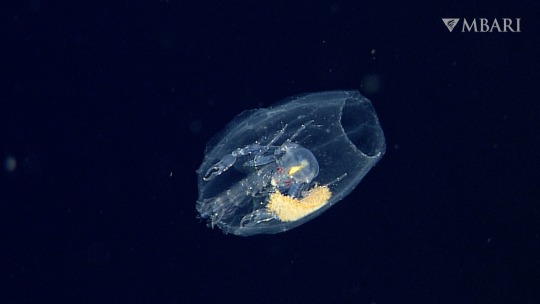
Hyperiid amphipods have evolved remarkably diverse eyes, each with different functional capabilities. While these amphipods are a relatively small group of crustaceans, the diversity of their eyes rivals that of terrestrial insects. Understanding their eye structures may one day help us develop new technologies for seeing in dark environments like caves, outer space, and the deep sea.
Learn more: https://www.uwa.edu.au/news/article/2024/may/deep-sea-eyes-evolved-to-focus-on-the-prize
127 notes
·
View notes
Text
New MBARI research!

New research on a field of pockmarks—large, circular depressions on the seafloor—offshore of Central California has revealed that powerful sediment flows, not methane gas eruptions, maintain these prehistoric formations.

Past research in other parts of the world has suggested that similar large seafloor depressions were formed and maintained by methane gas bubbling up through the sediments. With wind farms slated for construction offshore of Central California, resource managers were concerned about how the presence of methane gas might impact the stability of the seafloor in this region.

MBARI quickly moved to conduct this research in partnership with BOEM and USGS. We leveraged our advanced technology to answer critical questions about the stability of the seafloor to guide the development of offshore wind energy in California. Read the full story on our website.
97 notes
·
View notes
Text
Meet the Manefish, Caristius macropus
Named for their distinctive shape, macropus means large foot. This fish was observed in Monterey Bay 483 meters (1584 feet) deep in August of 2018. Manefish grow to be 35 centimeters (13 inches) long, but this individual was likely a juvenile measuring only about four centimeters (1.5 inches). They love to dine on siphonophores. Despite that, scientists think they may have a symbiotic relationship with the siphonophore Bathyphysa conifera, with the siphonophore providing shelter while the fish munches on their parasites.
Senior Research Technician in the video lab, Kyra Schlining selected this fascinating fish as one of her favorite moments because it’s so rare. MBARI has only filmed this animal twice, and Kyra was lucky enough to spot it on one of the many expeditions she’s participated in! “Spotting this little guy was particularly memorable because in over 20 years of watching deep-sea video I had never seen this animal before! We happened to be listening to “Who Can It Be Now” by Men at Work, and the fish was swimming perfectly in time to the beat. Everyone in the control room laughed until our faces hurt! We paused to watch the fish rock on until the song was over then continued on our research mission,” Kyra shared.
256 notes
·
View notes
Text
We’re all aflutter over the sea angel!
This swimming snail's rhythmic flapping and graceful movements resemble whimsical wings. The flappy bits you see sculling through the water aren’t wings at all—they’re basically a modified, slimy snail foot.
And despite its celestial appearance—the sea angel is a carnivorous hunter. With hidden tentacles tucked away inside its head, it tracks down prey and strikes!
2K notes
·
View notes
Text
A look into MBARI's video vault
This week, we’re sharing content curated by the team of experts responsible for our deep-sea video archive. Each member of the Video Lab Team has gone deep into the vault to find some of their favorite moments in MBARI’s history of ocean exploration. Get the inside scoop on some of the most interesting and unique observations they’ve made over the last few decades. Be sure to follow along all week as we share those moments with you!
In 36 years of deep-sea discoveries, MBARI’s remotely operated vehicles have completed more than 7,300 successful dives and recorded nearly 30,000 hours of deep-sea footage. This video archive includes more than 10 million observations about what we see on video—animals, behaviors, interactions, geological features, marine debris, and more—along with location, depth, and surrounding habitat characteristics. The Video Lab’s deep-sea experts comb through all of that footage with eagle eyes to identify and label animals and objects we film.
Learn more about the amazing team behind our stunning video!
161 notes
·
View notes
Text
Did you catch these cuties in our latest Deep Relaxocean video?
This black roughtail skate (Bathyraja trachura) is just one of the amazing animals featured in our latest episode. Skates are related to sharks. They have a distinct, flattened body, and they swim and glide using a pair of large, wing-like fins.
We often encounter skates resting on the sediment like this. Along with their expanded, muscular pectoral fins, some skates use their pelvic fins to maneuver while hunting along the bottom or to propel themselves off the seafloor when danger approaches.
Head over to our Animals of the Deep gallery and learn more about these spectacular skates.
75 notes
·
View notes
Text
#tfw you're too comfy to run away
Snailfishes are found globally in all ocean basins, from shallow intertidal waters to the deepest depths of the ocean to unsuspecting crabs that often serve as hosts to tiny snailfish eggs.
These slightly annoying but adorable fishes are well-adapted to a variety of habitats, including rocky outcrops, the muddy seafloor, and even the midwater. They play an important role as prey and predator in many ecosystems. Most snailfish species are small and feed on tiny invertebrates, but larger species may prey upon other fishes. MBARI has observed over a dozen species of snailfish in the past 34 years of exploration. We suspect there are dozens more out there waiting to be discovered.
Learn more about these overly-friendly fishes on our YouTube channel.
120 notes
·
View notes
Text
Twinkle twinkle little fish 🌟
The dollar hatchetfish (Sternoptyx diaphana) is about the size of a quarter. These tiny magicians can be found between 400 and 3,675 meters deep (1,312 to 12,057 feet). Light-producing organs in rows along their bellies help these little fish perform a deep-sea disappearing act.
Known as counterillumination, this adaptation allows the fish to match the daylight filtering from surface waters above and effectively hides the animal from predators that may be lurking below. Each species has a unique pattern of lights, and individuals can adapt their lights to whatever color is filtering down from the light above.
93 notes
·
View notes
Text
youtube
Unwind for six minutes with stunning footage of graceful deep-sea skates and rays filmed by MBARI’s underwater robots. Skates and rays are fishes related to sharks. They have a distinct, flattened body, and they swim and glide using a pair of large, wing-like fins. While we know a lot about the skates and rays that dwell in shallow coastal waters, we know relatively little about those that call the ocean’s inky depths their home.
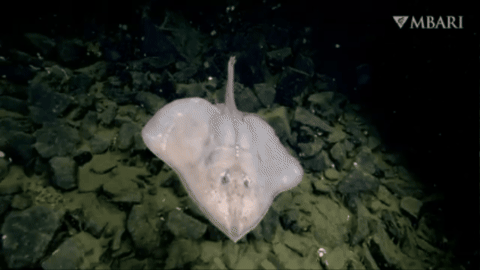
We often encounter skates resting on the sediment or skimming across the seafloor. Along with their expanded pectoral fins, some skates use their pelvic fins like legs to maneuver while hunting along the bottom or to propel themselves off the seafloor when danger approaches.
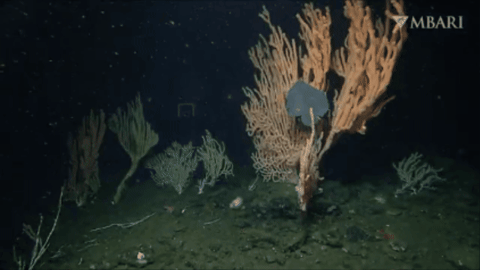
Our research is filling in the gaps in scientists’ baseline knowledge of rarely-seen deep-sea skate species. These data are especially important as climate change and overfishing continue to threaten biological communities. The more we learn about deep-sea sharks, skates, and rays, the better we can protect them and their habitats.
Learn more about deep-sea skates on our website.
217 notes
·
View notes
Text
Peep this deep-sea jelly, pretty in pinks and purples. But don’t be deceived by its petite size — the mauve stinger can pack a punch with stinging cells peppered across its tentacles and bell.
1K notes
·
View notes
Text
Meet the gulper eel
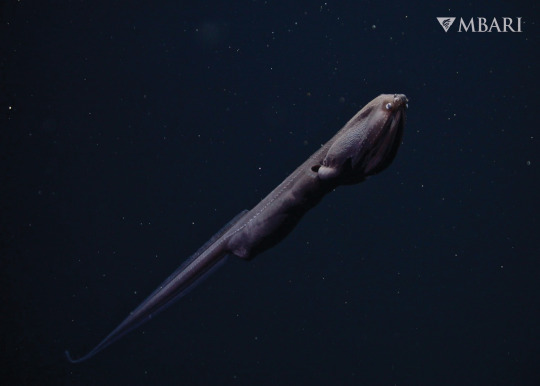
MBARI has studied the deep waters of Monterey Bay and beyond for more than 30 years. In our thousands of dives to these dark depths, we’ve only seen this species seven times.
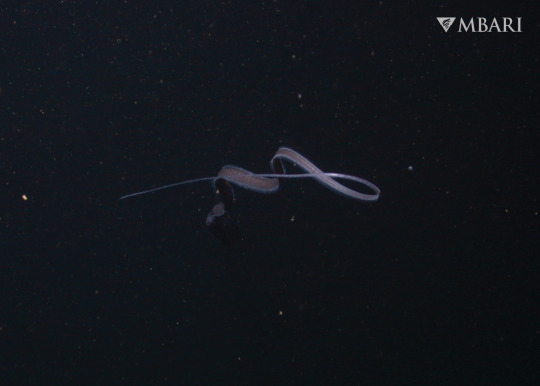
Gulper eels reach a maximum size of one meter and live between 300 and 2,000 meters deep.
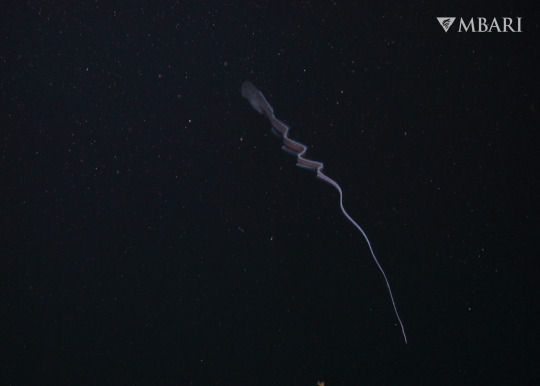
Learn more on our website.
903 notes
·
View notes
Text
Things you should give your mom for Mother’s Day—fancy jewelry, a bouquet of her favorite flowers, a nicely scented candle.
Things you shouldn’t give your mom for Mother’s Day—balloons that might end up in the ocean, expired cheese, that candle you got for Christmas from your aunt last year that's been sitting at the back of your closet until now.
As we celebrate the holiday, let’s reduce our reliance on single-use plastics (like balloons) and keep trash out of the ocean.
Learn more about trash in the deep sea on our website.
101 notes
·
View notes
Text
It's been a while so here's another deep-sea animal you've never heard of—the bottle comb jelly.
This species, Aulacoctena acuminate, was observed by our remotely operated vehicle Doc Ricketts at 1,146 meters (3,760 feet) deep. These comb jellies are ctenophores, not true jellies. Like other comb jellies, they navigate through the water by beating their shimmering, hair-like cilia.
MBARI researchers have learned that gelatinous animals like the bottle comb jelly have a large impact on deep-sea food webs. Our archive of nearly 28,000 hours of deep-sea video contains hundreds of observations of deep-sea animals feeding. Examining these observations in detail revealed that jellies, comb jellies, and siphonophores are important as both predators and prey in the ocean’s midnight zone.
Learn all about comb jellies and their deep-sea relatives in our Animals of the Deep gallery.
108 notes
·
View notes
Text
Spotted: an octopus playing the floor is lava 🐙🌋
Pillow lavas look like rounded blobs of solidified lava. They are formed as lava pours slowly out of the seafloor, and cold seawater cools the outer edge very quickly. Think about squeezing toothpaste out of a tube, but instead of it flowing freely, the outer skin of the toothpaste hardens as soon as it touches air. Pillow lavas come in various sizes and shapes, and each of these shapes can tell us a bit about the eruption that formed them.
Watch more video footage of these amazing geological formations on our YouTube channel.
12 notes
·
View notes